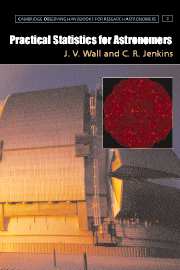Book contents
- Frontmatter
- Contents
- Preface
- Note on notation
- 1 Decision
- 2 Probability
- 3 Statistics and expectations
- 4 Correlation and association
- 5 Hypothesis testing
- 6 Data modelling; parameter estimation
- 7 Detection and surveys
- 8 Sequential data – 1D statistics
- 9 Surface distribution – 2D statistics
- Appendix 1 The literature
- Appendix 2 Statistical tables
- References
- Index
7 - Detection and surveys
Published online by Cambridge University Press: 02 September 2009
- Frontmatter
- Contents
- Preface
- Note on notation
- 1 Decision
- 2 Probability
- 3 Statistics and expectations
- 4 Correlation and association
- 5 Hypothesis testing
- 6 Data modelling; parameter estimation
- 7 Detection and surveys
- 8 Sequential data – 1D statistics
- 9 Surface distribution – 2D statistics
- Appendix 1 The literature
- Appendix 2 Statistical tables
- References
- Index
Summary
Watson, you are coming along wonderfully. You have really done very well indeed. It is true that you have missed everything of importance, but you have hit upon the method…
(Sherlock Holmes in ‘A Case of Identity’, Sir Arthur Conan Doyle)‘Detection’ is one of the commonest words in the practising astronomers' vocabulary. It is the preliminary to much else that happens in astronomy, whether it means locating a spectral line, a faint star or a gamma-ray burst. Indeed of its wide range of meanings, here we take the location, and confident measurement, of some sort of feature in a fixed region of an image or spectrum.
When a detection is obvious to even the most sceptical referee, statistical questions usually do not arise in the first instance. The parameters that result from such a detection have a signal-to-noise ratio so high that the detection finds its way into the literature as fact. However, elusive objects or features at the limit of detectability tend to become the focus of interest in any branch of astronomy. Then, the notion of detection (and non-detection) requires careful examination and definition.
Non-detections are especially important because they define how representative any catalogue of objects may be. This set of non-detections can represent vital information in deducing the properties of a population of objects; if something is never detected, that too is a fact, and can be exploited statistically. Every observation potentially contains information.
- Type
- Chapter
- Information
- Practical Statistics for Astronomers , pp. 142 - 180Publisher: Cambridge University PressPrint publication year: 2003

